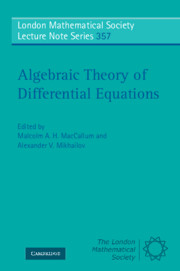Book contents
1 - Galois Theory of Linear Differential Equations
Published online by Cambridge University Press: 03 May 2010
Summary
Introduction
This paper is an expanded version of the 10 lectures I gave as the 2006 London Mathematical Society Invited Lecture Series at the Heriot-Watt University, 31 July - 4 August 2006. My goal was to give the audience an introduction to the algebraic, analytic and algorithmic aspects of the Galois theory of linear differential equations by focusing on some of the main ideas and philosophies and on examples. There are several texts ([1, 2, 3, 4, 5] to name a few) that give detailed expositions and I hope that the taste offered here will encourage the reader to dine more fully with one of these.
The rest of the paper is organized as follows. In Section 1.2, What is a Linear Differential Equation?, I discuss three ways to think about linear differential equations: scalar equations, linear systems and differential modules. Just as it is useful to think of linear maps in terms of linear equations, matrices and associated modules, it will be helpful in future sections to go back and forth between the different ways of presenting linear differential equations.
In Section 1.3, Basic Galois Theory and Applications, I will give the basic definitions and describe the Galois correspondence. In addition I will describe the notion of monodromy and its relation to the Galois theory. I will end by giving several applications and ramifications, one of which will be to answer the question Although y = cos x satisfies y″ + y = 0, why doesn't sec x satisfy a linear differential equation?
Information
- Type
- Chapter
- Information
- Algebraic Theory of Differential Equations , pp. 1 - 82Publisher: Cambridge University PressPrint publication year: 2008
Accessibility standard: Unknown
Why this information is here
This section outlines the accessibility features of this content - including support for screen readers, full keyboard navigation and high-contrast display options. This may not be relevant for you.Accessibility Information
- 7
- Cited by
